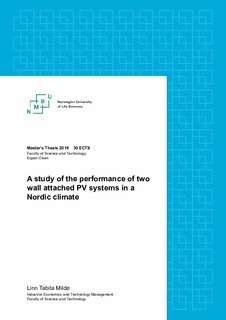A study of the performance of two wall attached PV systems in a Nordic climate
Master thesis
Submitted version
Permanent lenke
http://hdl.handle.net/11250/2566913Utgivelsesdato
2018Metadata
Vis full innførselSamlinger
- Master's theses (RealTek) [1722]
Sammendrag
Mengden installert PV i Norge øker. Bygningsfestet og bygningsintegrerte solceller har blitt populære, og markedet for næringsbygg øker. Det er viktig å ta hensyn til den potensielle produksjonen når det installeres et PV system. Designet til systemet burde passe med bygningens struktur, omgivelser, og lokasjon. I tillegg er lønnsomheten viktig når man skal velge hvilket system man skal bygge.
Poenget med studiet er å analysere opptredenen til to veggmonterte systemer ved Kjeller i Norge, og finne ut hvordan de blir påvirket i et Nordisk klima. Det første systemet er et 1.30 kWp Polykrystallinsk (pc-Si) PV system og det andre er et 1.32 kWp Kobber-indium-gallium-selenid (CIS) PV system. Produksjons- og værdata fra teststedet, mellom 1. februar 2017 og 31. januar 2018, er brukt i analysen. Den gjennomsnittlige årlige sluttytelse, referanseytelse, utnyttelsesgrad og system effektivitet er beregnet for begge systemene. The amount of installed PV in Norway is increasing. Building applied and building integrated PV has become popular, and the market for commercial buildings is growing. The potential production is important to consider when installing a PV system. The design of the system should agree with the building structure, the surroundings, and the location. Also, the profitability is important when choosing what system to build.
The objective of this study is to analyze of the performance of two wall attached systems at Kjeller in Norway, and how they are affected in the Nordic climate. The first system is a 1.30 kWp Poly crystalline silicon (pc-Si) PV system and the second is a 1.32 kWp Copper indium gallium selenide (CIS) PV system. Output and weather data from the test location, between the 1st of February 2017 and the 31st of January 2018, are used for the analysis. The average annual final yield, reference yield, performance ratio, and system efficiency are calculated for both systems.

